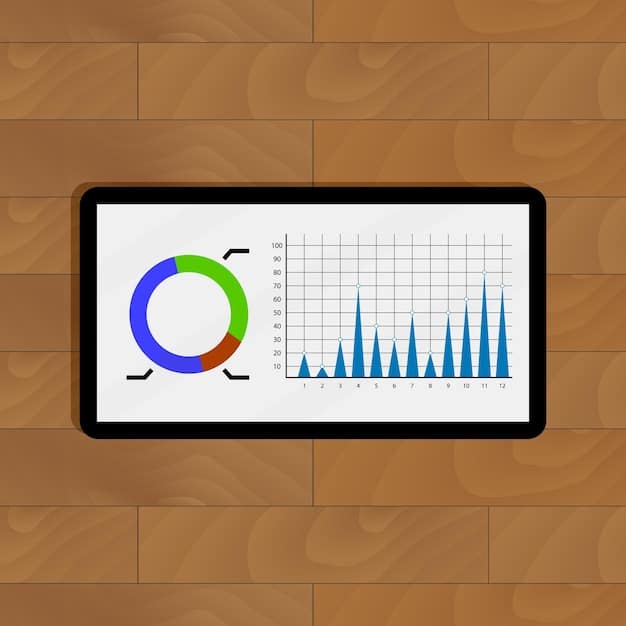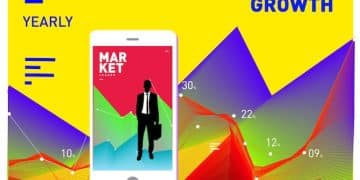Social Media Analytics: Identify Top Content in 30 Minutes

Social media analytics empowers you to quickly identify your top-performing content by tracking key metrics, understanding audience engagement, and optimizing your strategy for maximum impact, often within just 30 minutes.
Want to know which of your social media posts are really hitting the mark? Social media analytics: Identify Your Top Performing Content in 30 Minutes is easier than you think, and it can have a huge impact on your social media strategy. Learning how to quickly analyze your data can save you time and help you focus on what truly resonates with your audience.
Understanding the Basics of Social Media Analytics
Social media analytics isn’t just about counting likes and shares. It’s a powerful tool that can offer deep insights into your audience, content performance, and overall social media strategy.
By understanding the basics, you can quickly identify what’s working and what’s not, allowing you to make data-driven decisions in real-time.
What are Key Performance Indicators (KPIs)?
KPIs are the metrics you use to measure the success of your social media efforts. They provide a clear picture of whether you’re achieving your goals.
Common Social Media KPIs
Here are some of the most common KPIs to track:
- Reach: The number of unique users who saw your content.
- Engagement: The total number of interactions (likes, comments, shares) your content received.
- Click-Through Rate (CTR): The percentage of people who clicked on a link in your post.
- Conversion Rate: The percentage of people who completed a desired action (e.g., signing up for a newsletter, making a purchase) after clicking on your post.
These are just a few examples; the specific KPIs you track will depend on your business goals. For instance, if you’re focused on brand awareness, reach might be your primary KPI.
Understanding these basics allows you to dive into more advanced analytics techniques and truly identify your top-performing content.

Setting Up Google Analytics for Social Media Tracking
While social media platforms offer built-in analytics, Google Analytics provides a more comprehensive view of your website traffic driven by social media.
Setting it up correctly is key to understanding the true impact of your social media efforts on your website.
Creating Custom URLs with UTM Parameters
UTM parameters are tags you add to your URLs to track where your website traffic is coming from. They allow you to see exactly which social media posts are driving the most traffic and conversions.
How to Use Google’s Campaign URL Builder
Google offers a free Campaign URL Builder that makes it easy to create custom URLs with UTM parameters. Simply enter your website URL, the source (e.g., Facebook, Twitter), the medium (e.g., social media), and the campaign name (e.g., summer sale).
- Source: Identifies the platform (e.g., facebook, instagram).
- Medium: Identifies the type of link (e.g., social, cpc).
- Campaign: Identifies a specific promotion or campaign (e.g., summer_sale).
Using UTM parameters ensures you have accurate data in Google Analytics, making it easier to pinpoint your best-performing content. It closes the loop between social media activity and website performance.
By using Google Analytics and UTM parameters, you gain a more complete understanding of how your social media efforts contribute to your overall business goals.
Using Native Social Media Analytics Tools
Each social media platform offers its own analytics tools that provide valuable insights into your audience and content performance. These tools are often free and easy to use.
Understanding how to leverage these native tools can help you quickly identify your top-performing content on each platform.
Exploring Facebook Insights
Facebook Insights provides detailed data about your page’s performance, including reach, engagement, and audience demographics. It allows you to see which posts are resonating with your audience.
Leveraging Twitter Analytics
Twitter Analytics offers insights into your tweets’ performance, including impressions, engagement rate, and profile visits. It helps you understand what type of content drives the most engagement on Twitter.
Instagram Insights for Visual Content
Instagram Insights provides data about your posts, stories, and audience demographics. It’s particularly useful for understanding the performance of your visual content, such as photos and videos.
- Reach and Impressions: How many people saw your content.
- Engagement: Likes, comments, shares, and saves.
- Profile Activity: Website clicks and follows.
By mastering these native analytics tools, you can gain a deeper understanding of your audience and content performance on each platform.
Native social media analytics tools offer a wealth of information to help you refine your content strategy and maximize your impact on each platform.
Identifying Your Top Performing Content
Now that you’ve set up your analytics tools, it’s time to start identifying your top-performing content. This involves analyzing your data to see which posts are driving the most engagement and conversions.
By focusing on your best-performing content, you can create more of what your audience loves and maximize your social media ROI.
Analyzing Engagement Metrics
Engagement metrics (likes, comments, shares) are a key indicator of how well your content is resonating with your audience. Look for patterns in your top-performing posts, such as topics, formats, and posting times.
Tracking Click-Through Rates
Click-through rates (CTR) measure how many people clicked on a link in your post. A high CTR indicates that your content is driving traffic to your website or landing page.
Measuring Conversion Rates
Conversion rates track how many people completed a desired action (e.g., signing up for a newsletter, making a purchase) after clicking on your post. This metric is crucial for measuring the ROI of your social media efforts.
- High Engagement Posts: Topics, formats, and visuals that resonate most.
- High CTR Posts: Offers or content that drives traffic.
- High Conversion Posts: Content that leads to desired actions like sales or sign-ups.
Identifying your top-performing content involves analyzing your data to see which posts are driving the most engagement, traffic, and conversions.
Identifying top content allows you to understand what resonates with your audience and replicate that success in future posts.

Optimizing Your Social Media Strategy
Once you’ve identified your top-performing content, it’s time to optimize your social media strategy based on your findings. This involves creating more of what your audience loves and refining your approach to drive even better results.
Optimization isn’t a one-time task; it’s an ongoing process of testing, measuring, and refining.
Repurposing Top-Performing Content
Take your best-performing posts and repurpose them into different formats, such as blog posts, infographics, or videos. This allows you to reach a wider audience and maximize the value of your content.
Refining Your Posting Schedule
Analyze your data to identify the best times to post on each platform. This will help you reach more of your audience and increase engagement.
Experimenting with New Content Formats
Don’t be afraid to experiment with new content formats, such as live video, stories, or interactive content. This can help you keep your audience engaged and discover new ways to drive results.
- Diversify Content: Turn popular posts into videos, infographics, or blog articles.
- Optimal Timing: Schedule posts based on when your audience is most active.
Optimizing your social media strategy involves repurposing content, refining your posting schedule, and experimenting with new formats.
Consistently optimizing your approach ensures that you’re always maximizing your impact on each platform and increasing your ROI.
Tools to Enhance Your Social Media Analytics
While native analytics and Google Analytics provide a solid foundation, several third-party tools can offer even deeper insights and automation.
These tools can help you save time and gain a more comprehensive understanding of your social media performance.
Buffer Analyze for Streamlined Reporting
Buffer Analyze offers streamlined reporting and insights across multiple social media platforms. It helps you track your KPIs and identify trends in your data.
Hootsuite Analytics for Comprehensive Insights
Hootsuite Analytics provides comprehensive insights into your social media performance, including audience demographics, engagement rates, and website traffic.
Sprout Social for Advanced Analytics and Reporting
Sprout Social offers advanced analytics and reporting features, including competitive analysis, sentiment analysis, and custom reports. It’s a powerful tool for enterprise-level social media management.
- Buffer Analyze: User-friendly reporting across platforms.
- Hootsuite Analytics: In-depth performance tracking.
- Sprout Social: Advanced features like competitive and sentiment analysis.
These third-party tools can provide a more detailed and automated view of your social media performance, helping you save time and make data-driven decisions.
Using the right tools can significantly enhance your social media analytics capabilities and improve your overall results.
| Key Point | Brief Description |
|---|---|
| 📊 Understanding KPIs | Key Performance Indicators help measure social media success. |
| 🔗 UTM Parameters | Used to track website traffic from social media campaigns. |
| 📈 Native Analytics | Provides data on audience and content performance. |
| 🚀 Optimization | Refine strategy based on analytics to improve results. |
Frequently Asked Questions (FAQs)
Key KPIs include reach, engagement, click-through rate, and conversion rate. The specific KPIs that matter most depends on your goals.
Use Google’s Campaign URL Builder to create custom URLs with UTM parameters for tracking traffic sources in Google Analytics.
Avoid neglecting data, not setting clear goals, and failing to act on insights. Make sure to consistently analyze and optimize.
Yes, competitive analysis tools can help you track your competitors’ performance and identify opportunities to improve your own strategy.
It’s a good practice to review your analytics weekly to identify trends and optimize your strategy for the best business outcomes.
Conclusion
By mastering the art of social media analytics, you can quickly identify your top-performing content and optimize your strategy for maximum impact. From understanding the basics to leveraging native tools and third-party solutions, the possibilities are endless. Embrace the power of data and watch your social media efforts soar.





